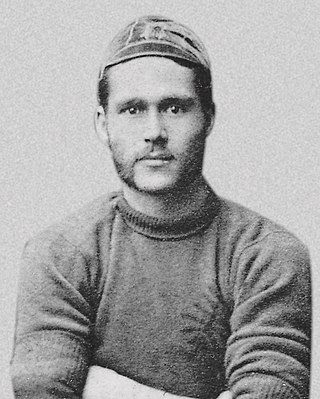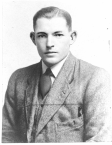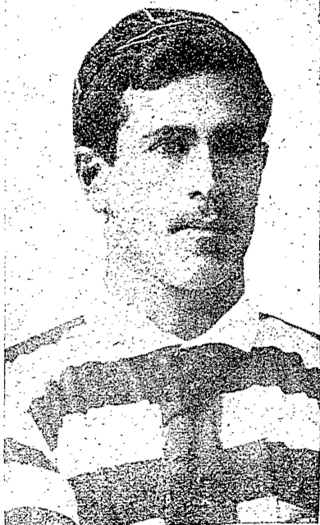Related Research Articles

Sir Michael Niko Jones is a New Zealand former rugby union player and coach.

Joseph Astbury Warbrick was a Māori rugby union player who represented New Zealand on their 1884 tour to Australia and later captained the 1888–89 New Zealand Native football team that embarked on a 107-match tour of New Zealand, Australia, and the British Isles.

Arthur Cooper "Johnnie" Wallace was an Australian rugby union player, a state and national representative three-quarter who captained the Waratahs on 25 occasions in the 1920s as well as representing Scotland early in his career.

Syd Malcolm (1902–1987) was an Australian rugby union player, a state and national representative half-back who captained the Wallabies' on seventeen occasions between 1928 and 1933.

Tom Lawton Snr was an Australian rugby union player, a state and national representative five-eighth who made 44 appearances for the Wallabies, played in 14 Test matches and captained the national side on ten occasions.
Charlie Fox was an Australian rugby union player, a state and national representative second-rower who made 36 appearances for the Wallabies, playing in 17 Test matches and captained the national side on seven occasions in 1925.

The 1907–1908 New Zealand rugby tour of Australia and Great Britain was made by a group of New Zealand rugby footballers who played matches in Australia, Ceylon, England and Wales between 1907 and 1908. Most of the matches were played under the rules of the Northern Union, a sport that is today known as rugby league. As such, the team were the immediate predecessors of the New Zealand national rugby league team. The tour had a large role in establishing rugby league in both Australia and New Zealand, and also gave birth to international rugby league. The tour party has come to be known as the professional All Blacks or All Golds, although at the time they were commonly referred to as the All Blacks—a named popularised by the New Zealand rugby union team that toured the Northern Hemisphere in 1905.
Alexander William Ross was an Australian state and national representative rugby union player who captained the Wallabies in thirteen Test matches in 1933-34.
Lawrence Joseph Dwyer was an Australian rugby union player, a state and national representative fullback who captained the Wallabies in 1913.
William Beverley James Sheehan was an Australian rugby union player, a state and national representative fly-half in the 1920s. Eighteen of his New South Wales state appearances have since been decreed as Test matches by the Australian Rugby Union and Sheehan, who led the side in three such matches in 1923, was therefore a captain of the Australian national team.
Edward Joseph "Ted" Thorn was an Australian rugby union player, a state and national representative flanker who made 36 appearances for the Waratahs. He played in fifteen Test matches and was captaining the national side on thirteen occasions between 1924 and 1926.

The 1910 Great Britain Lions tour of Australia and New Zealand was the first international tour of the Great Britain national rugby league team, "The Lions". They played the second ever Ashes series against Australia, and their first as the visiting team, before travelling to Auckland to take on New Zealand. The tour was a huge promotional and financial success for what was then known as the "Northern Union" game and helped set the pattern for regular, alternating test match series between Britain and Australia. It is regarded as one of the most important events in the history of rugby league.

Arapeta Paurini Wharepapa, or Albert Asher as he was more commonly known, was a New Zealand dual-code international rugby union and professional rugby league footballer who played in the 1890s, 1900s, 1910s and 1920s. At representative level Asher played rugby union for New Zealand, North Island and Auckland playing on the Wing and played rugby league at representative level for Australasia, New Zealand, Auckland and the New Zealand Māori rugby league team. One of his brothers, Ernie, was also a rugby league international while another, John, became a Ngati Pukenga and Ngati Pikiao leader, and another brother, Thomas also played representative rugby for Tauranga. Katherine Te Rongokahira Parata was a sister.
Gregory Victor Davis was a New Zealand born, national representative rugby union player for Australia. He played at flanker and made seven international tours with Wallaby squads. He was the Australian national captain in 47 matches from 1969 to 1972 and led the Wallaby side on three overseas tours.
Geoffrey Arnold Shaw is an Australian former national representative rugby union player who played for and captained the Wallabies. He made state representative appearances for both New South Wales and Queensland over an eleven-year period from 1969.

William Cunningham was a New Zealand rugby union player who represented New Zealand—known as the All Blacks—between 1901 and 1908. Most notably he toured with the Original All Blacks on their 1905–06 tour of the British Isles, France and North America. They were the first New Zealand representative team to visit the British Isles, and of their 32 matches there Cunningham played in 23. He played mainly at lock, and was added to the touring party due to his strong scrummaging ability. He played in three Test matches during the trip: against Scotland, Ireland and France, but did not play in the loss to Wales due to injury, the All Blacks' only defeat on tour.

Rieko Edward Ioane is a New Zealand professional rugby union footballer who plays as a wing or as a centre for New Zealand team Blues in Super Rugby and the New Zealand national team. In his youth career, he was selected to play in the 2014 and 2015 Sevens World Series for New Zealand and took part in Auckland Grammar School first XV, the top representative team in secondary school.
George Paki was a New Zealand international rugby league player. He debuted for New Zealand in 1921 and became Kiwi number 151 in the process. He also played for New Zealand Māori rugby league team and an unofficial New Zealand Māori rugby side which toured Australia and New Zealand in 1913.

Charles Gregory was a rugby league player who represented New Zealand in 40 matches including 3 tests from 1925 to 1930. When he debuted for New Zealand in 1925 he became Kiwi number 171. He predominantly played fullback during his career though he played standoff and centre at various points. He also represented Auckland in both rugby league and rugby union and played for the Ponsonby rugby club and the Marist rugby league club.
References
- ↑ "Benefit Day". Thames Star. 11 September 1936.
- ↑ "Mick Lomas #310". stats.allblacks.com.
- ↑ "Thames Valley rugby". nzhistory.govt.nz.